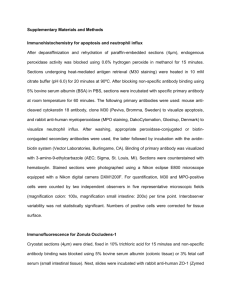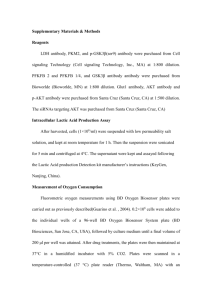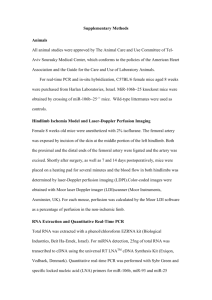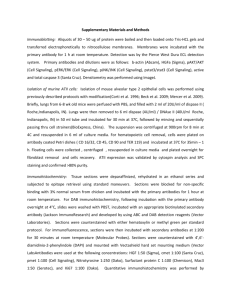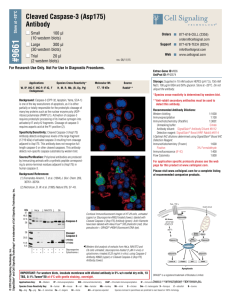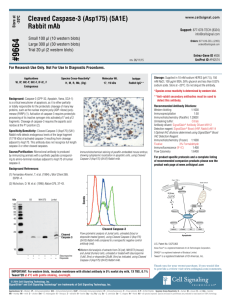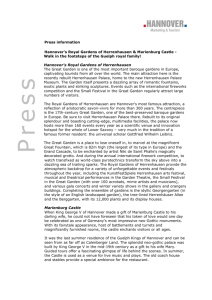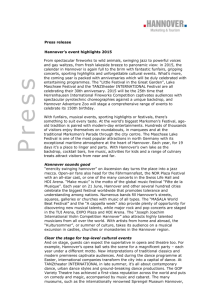HEP_26082_sm_SuppInfo
advertisement
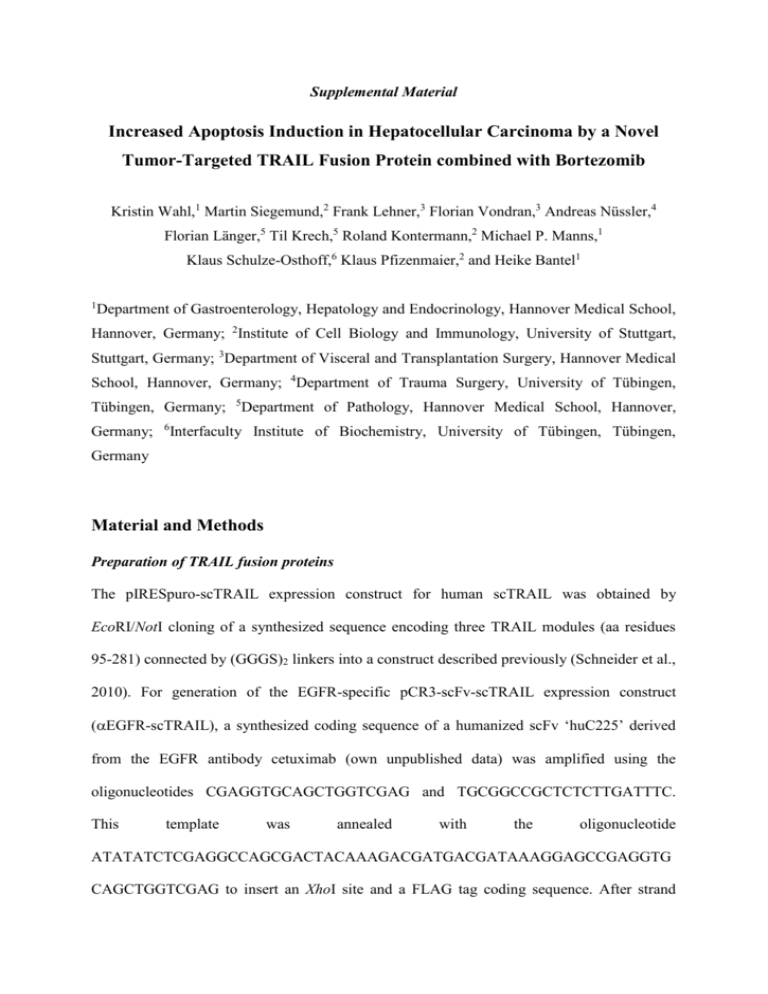
Supplemental Material Increased Apoptosis Induction in Hepatocellular Carcinoma by a Novel Tumor-Targeted TRAIL Fusion Protein combined with Bortezomib Kristin Wahl,1 Martin Siegemund,2 Frank Lehner,3 Florian Vondran,3 Andreas Nüssler,4 Florian Länger,5 Til Krech,5 Roland Kontermann,2 Michael P. Manns,1 Klaus Schulze-Osthoff,6 Klaus Pfizenmaier,2 and Heike Bantel1 1 Department of Gastroenterology, Hepatology and Endocrinology, Hannover Medical School, Hannover, Germany; 2Institute of Cell Biology and Immunology, University of Stuttgart, Stuttgart, Germany; 3Department of Visceral and Transplantation Surgery, Hannover Medical School, Hannover, Germany; 4Department of Trauma Surgery, University of Tübingen, Tübingen, Germany; 5Department of Pathology, Hannover Medical School, Hannover, Germany; 6 Interfaculty Institute of Biochemistry, University of Tübingen, Tübingen, Germany Material and Methods Preparation of TRAIL fusion proteins The pIRESpuro-scTRAIL expression construct for human scTRAIL was obtained by EcoRI/NotI cloning of a synthesized sequence encoding three TRAIL modules (aa residues 95-281) connected by (GGGS)2 linkers into a construct described previously (Schneider et al., 2010). For generation of the EGFR-specific pCR3-scFv-scTRAIL expression construct (EGFR-scTRAIL), a synthesized coding sequence of a humanized scFv ‘huC225’ derived from the EGFR antibody cetuximab (own unpublished data) was amplified using the oligonucleotides CGAGGTGCAGCTGGTCGAG and TGCGGCCGCTCTCTTGATTTC. This template was annealed with the oligonucleotide ATATATCTCGAGGCCAGCGACTACAAAGACGATGACGATAAAGGAGCCGAGGTG CAGCTGGTCGAG to insert an XhoI site and a FLAG tag coding sequence. After strand elongation, the oligonucleotides ATATATCTCGAGGCCAGCGAC and ATATGAATTCTGCGGCCGCTCTCTTGATTTC were used for PCR. The product was cloned via XhoI/EcoRI into pCR3 (Invitrogen, Darmstadt; Germany), carrying a VH leader and a dummy scFv-scTRAIL sequence. The scTRAIL-coding sequence was then substituted via EcoRI/XbaI cloning, using the same sequence as for scTRAIL expression. TRAIL proteins were produced in HEK293 cells and purified from supernatants by immobilized metal affinity chromatography followed by affinity chromatography on anti-FLAG mAb M2 agarose (Sigma-Aldrich, Steinheim, Germany).1-2 Cell viability assays After incubation of PHHs or Huh7 cells with the different stimuli cell viability was measured by MTT (3-[4,5-dimethylthiazol-2-yl]-2,5-diphenyltetrazolium bromide) colorimetric assay. MTT (50 µg/well; Sigma-Aldrich) was added to the cells for 4 hours at 37°C, before supernatants were removed and cells were lysed with 95% isopropanol/5% acetic acid. Absorption was measured at 550 nm. Alternatively, cell viability was measured by the standard crystal violet assay. Cells were stained with 20% methanol containing 0.5% crystal violet and solubilized in 33% acetic acid. The absorbance was measured at 590 nm. Values of untreated cells represented 100% viability. Caspase activity assays Following incubation with the respective agents, liver tissue was pulverized in liquid nitrogen. Pulverized liver tissue, hepatoma cells and PHHs were lysed in a cocktail of 0.5% Nonidet P40, 10 mM Tris-HCl pH 7.4, 10 mM MgCl2, 150 mM NaCl, 10 mM dithiothreitol, and 1% protease inhibitor (Sigma-Aldrich). After 30 min of incubation on ice, the lysates were cleared by centrifugation and measured for protein content by the bicinchoninic acid assay (Thermo Scientific, Braunschweig, Germany). Activity of caspase-3 and caspase-7 was measured in duplicate by a luminescent substrate assay (Caspase-Glo, Promega, Mannheim, Germany) as described.3 The assay provides a luminescent substrate with the caspase cleavage sequence DEVD in a reagent optimized for caspase activity and luciferase activity. Following cleavage of the substrate at the DEVD peptide by activated caspase-3 and caspase-7, aminoluciferin is released, resulting in light production in a luciferase reaction, which can be measured in relative light units (RLU) by a luminometer. First, cell extracts were diluted in 50 mM TrisHCl (pH 7.4), 10 mM KCl, and 5% glycerol to reach a final protein concentration of 1 mg/mL. Then, 10 µl of the extracts were incubated with 10 µl of the caspase substrate DEVD-luciferin and luciferase reagent for 2 hours at room temperature. Luminescence of the samples was measured in duplicate in a luminometer (LB 960, Berthold, Bad Wildbad, Germany) and calculated as the increase relative to that of the untreated control. Immunoblotting Proteins were separated under reducing conditions on a 12% SDS-polyacrylamide gel and electroblotted to a polyvinylidene difluoride membrane (BioRad, Munich, Germany). Membranes were blocked for 1 hour with 5% nonfat dry milk powder in Tris-buffered saline (TBS: 20 mM Tris-HCL pH 7.5, 150 mM NaCl) and then incubated overnight at 4°C with anti-caspase-8 antibody (BioCheck, Münster, Germany) and anti-glycerinaldehyde-3phosphate-dehydrogenase antibody (GAPDH; Cell Signaling Technology) as control. Membranes were washed with TBST (TBS with 0.2% Tween-20) and incubated with the horseradish peroxidase-conjugated secondary antibodies for 1 hour. Following extensive washing, the reaction was developed by enhanced chemiluminescent staining (GE Healthcare, Munich, Germany). Immunohistochemistry Frozen sections (10 µm) of healthy or HCC liver explants, either untreated or treated with the different agents, were stained for active caspase-3 using an anti-cleaved caspase-3 (Cell Signaling Technology, Danvers, MA, USA) or caspase-cleaved cytokeratin-18 antibody (M30, Roche, Mannheim, Germany). The sections were fixed in acetone, followed by washing in Tris-HCl (pH 7.4). Following inhibition of endogenous peroxidase, nonspecific binding was blocked with 1% bovine serum albumin for 1 hour. Sections were then incubated overnight at 4°C with anti-cleaved caspase-3 or M30 antibodies. After repeated washing, sections were incubated for 30 minutes with biotinylated secondary antibody and covered for 1 hour with avidin-biotin complex reagent (ABC kit, Vector Laboratories, Burlingame, CA). Finally, the sections were stained in aminoethylcarbazole solution and counterstained with hematoxylin. For TUNEL staining (cell death detection kit, Roche) frozen sections were permeabilized for 30 minutes with 0.1 % Triton X-100 in 0.1% sodium citrate (pH 4.7), washed in PBS and then incubated for 1 hour at 37°C in a reaction mixture (200 mM potassium cacodylate, 25 mM Tris-HCl pH 6.6, 1 mM cobalt chloride, 0.25 mg/mL bovine serum albumin) containing terminal deoxynucleotidyl transferase (0.2 U/µl) and fluorescein isothiocyanate-labeled deoxyuridine triphosphate.4 Sections were embedded in fluorescence-mounting medium containing DAPI (4’,6-diamidino-2-phenylindole; Vector Laboratories). Paraffin sections were deparaffinised and stained for EGFR expression using the antibody 2-1E1 (1:200, Zytomed, Berlin, Germany) according to standard procedures. Supplemental References 1. Schneider B, Münkel S, Krippner-Heidenreich A, Grunwald I, Wels WS, Wajant H, et al. Potent antitumoral activity of TRAIL through generation of tumor-targeted single-chain fusion proteins. Cell Death Dis 2010; doi:10.1038/cddis.2010.45 2. Siegemund M, Pollak N, Seifert O, Wahl K, Hanak K, Vogel A, et al. Superior antitumoral activity of dimerized targeted single-chain TRAIL fusion proteins under retention of tumor selectivity. Cell Death Dis 2012; doi:10.1038/cddis.2012.29 3. Seidel N, Volkmann X, Länger F, Flemming P, Manns MP, Schulze-Osthoff K, et al. The extent of liver steatosis in chronic hepatitis C virus infection is mirrored by caspase activity in serum. HEPATOLOGY 2005;42:113-120. 4. Volkmann X, Fischer U, Bahr MJ, Ott M, Lehner F, MacFarlane M, et al. Increased hepatotoxicity of tumor necrosis factor-related apoptosis-inducing ligand in diseased human liver. HEPATOLOGY 2007;46:1498-1508.

![[supplementary informantion] New non](http://s3.studylib.net/store/data/007296005_1-28a4e2f21bf84c1941e2ba22e0c121c1-300x300.png)

